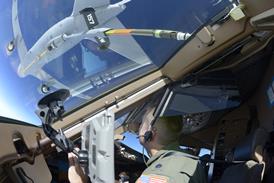US defence research agency wants to develop air vehicle small enough to fly inside caves and tunnels
The US Defense Advanced Research Projects Agency (DARPA) is to develop and demonstrate unmanned air vehicles small enough to operate inside caves and tunnels. Bidders were briefed at the Nano Air Vehicle (NAV) programme launch last week.
DARPA is looking for a UAV that weighs less than 10g (0.35oz) including a 2g payload, and is smaller than 5cm (2in) in any dimension. This compares with the 200g weight class of the agency’s Micro Air Vehicle (MAV), now being field-tested.
“The warfighter needs something that can navigate inside a building, cave or tunnel, where MAVs can’t go,” says NAV programme manager Darryl Pines. “We need something even smaller that can fly through a window and provide situational awareness inside a building.”
DARPA’s goal is to “provide a clear direction for development of a system that will be useful to the warfighter,” says Pines. “We understand the fundamental physics. This is about integrating technology into a vehicle that can perform a notional mission.” The requirement is for an air vehicle that can fly more than 1,000m (3,280ft) at 7-10m/s, loiter at 0.5m/s for more than 60s then hover in place for another minute or more, sending video back to the operator. The vehicle could be expendable or reusable, he says.
The NAV programme is expected to investigate flapping-wing and other “biologically inspired” designs that were too immature to be considered for the MAV. “The MAV is four to five years ahead of the NAV, and has helped develop our fundamental understanding of how to generate lift at low Reynolds numbers,” says Pines.
An aerodynamic term that relates vehicle size and speed to air density and viscosity, Reynolds number could be “1,000 or less” for the NAV, says Pines.
DARPA plans to award multiple contracts for an 18-month first phase of the NAV programme, which will end with preliminary design reviews. One contractor will be selected for the 18-month second phase, which will include flight tests.
GRAHAM WARWICK/WASHINGTON DC
Source: Flight International























